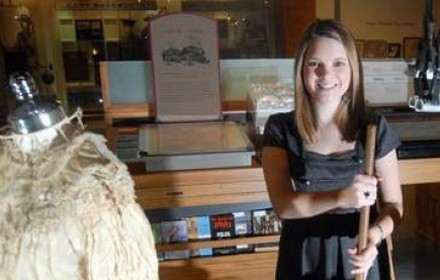Student Coordinates Women’s History Exhibit at Museum

by Brittany Pack ’12, history major
Being from Spartanburg, I had heard of Converse but never thought it was for me until I took a tour. I fell in love with the history and the traditions of the college and decided to transfer from another school. I was scared at first to be a new student all over again, but after only one day at Converse I knew I had made the right decision. Once I got settled in and joined some clubs reality hit: I didn’t know what I wanted to do with my history degree after school. My advisor encouraged me to look for an internship, so I took his advice and called the Spartanburg Regional History Museum. They asked me to start the following week. That’s when everything began to fall right into place. For the first time in my life I had a job I actually wanted to go to. My supervisor gave me tasks in different areas of museum work so I could learn as much as possible. I cataloged artifacts, gave tours, helped with grant writing, etc. I thought being a Museum Curator might be fun, so one day my supervisor asked if I would be in charge of the Women’s History Exhibit.
I’ve always been fascinated by history, but it wasn’t until college that I became interested in women’s history. High school history classes tend to skip over women and only talk about presidents and wars. Coming from a younger generation I didn’t realize fully all the struggles women experienced. Dr. Walker’s ‘Women in American History’ class here at Converse helped me realize just how much women have done throughout history to make a difference. Everyone knows that women cooked, cleaned and took care of the children. While these are important roles, there are so many more. I was so excited to be in charge of the exhibit, and I wanted it to use the opportunity to give credit to women who were never listed in history books even though they should have been. I wanted to put a unique twist on the exhibit to draw in all kinds of groups.
It didn’t take very long to pick the theme of the exhibit: women’s roles in Spartanburg history. I spent six weeks looking through the museum’s collection of artifacts and researching. I collected the basics first, such as a waffle iron, sewing machine, washboard, etc, and then I started looking for more unusual items that would show the various roles women have played.
I believe World War II was a turning point in women’s history because women were working outside of the home more than ever before. In Spartanburg, especially, women commonly worked in agriculture and mills so I wanted to emphasize how these areas of history and economy were affected by the war and women. While looking through the artifacts collection, I found several portraits of unknown women. Meghan McCraw, another Converse student intern, and I searched the museum’s files and the internet to figure out who these women were. One was Miss South Carolina in 1970 and the only woman from Spartanburg to make it to the Miss America finals. One owned her own business during the 1930’s and another was of the first female from Spartanburg to be elected to the State Legislature. It made me proud to know so many prominent women had called Spartanburg their home. The Museum’s Executive Director, Becky Slayton, loaned me a book exclusively about Spartanburg Women. From this book I learned that South Carolina’s first Women’s Suffrage Organization was founded right here in Spartanburg. The first female to graduate from the University of South Carolina’s medical school chose to practice right here.
With more research came more pride. Converse women have been outstanding throughout history. Margret Law was an artist ahead of her time. She never married and she traveled alone during a time when that was unacceptable. Mary Ellen Suit was an art major as well. Her talent for drawing was so incredible that the government hired her to draw maps for the war during World War II. Also during the war, several Converse students volunteered to help local farms harvest crops while the men were away.
The faculty at Converse and the staff at Spartanburg Regional History Museum are helping prepare me for the real world, and I am so thankful for the opportunity to learn as well as to educate the community.